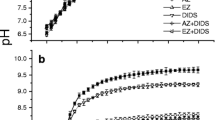Abstract—
Dissolved organic matter (DOM) release by anoxygenic phototrophic bacteria belonging to diverse taxonomic groups is a ubiquitous process, resulting in 5–20% of the CO2 fixed by photosynthesis leaving the cell. The green photosynthetic bacterium Chlorobaculum limnaeum releases ~10% of the carbon assimilated during autotrophic СО2 fixation. Extracellular DOM release by Cba. limnaeum is a normal function of living cells, since it does not occur in the dark and is inhibited by fluoroacetate, an inhibitor of СО2 fixation via the reducing TCA acids cycle, which is used for CO2 assimilation in this bacterium. In the presence of acetate or pyruvate in the medium, DOM release increases to 30 and 60%, respectively. Nitrogen limitation stimulates DOM release by Cba. limnaeum up to 60% of assimilated СО2. Under these conditions, addition of acetate results in DOM release increasing up to 100%. Therefore, the extracellular release of DOC by anoxygenic phototrophic bacteria can be considered as an important source of substrates for the growth of heterotrophic bacteria in oxygen-free aquatic ecosystems.




Similar content being viewed by others
REFERENCES
Bauer, C., Setterdahl, A., Wu, J., and Robinson, B.R., Regulation of gene expression in response to oxygen tension, in Advances in Photosynthesis and Respiration, Hunter, C.N., Ed., Berlin: Springer, 2009, vol. 28, pp. 707‒722.
Biebl, H. and Pfennig, N., Growth yields of green sulfur bacteria in mixed cultures with sulfur and sulfate reducing bacteria, Arch. Microbiol., 1978, vol. 117, pp. 9–16.
Buchanan, B.B. and Arnon, D.I., A reverse KREBS cycle in photosynthesis: consensus at last, Photosynth. Res., 1990, vol. 24, pp. 47‒53.
Carlson, C.A., Production and removal processes, in Biogeochemistry of Marine Dissolved Organic Matter, Hansell, D.A. and Carlson, C.A., Eds., San Diego: Academic, 2002, pp. 91‒151.
Carlson, C.A. and Hansell, D.A., DOM sources, sinks, reactivity, and budgets, in Biogeochemistry of Marine Dissolved Organic Matter, 2nd ed., Hansell, D.A. and Carlson, C.A., Eds., Boston: Academic, 2015, pp. 65‒126.
Castenbolz, R.W. and Pierson, B.K., Isolation of members of the family Chloroflexaceae, in The Prokaryotes, Starr, P., Stolp, H., Truper, Y.G., Balows, A., and Schlegel, H.G., Eds., Berlin: Springer, 1981, vol. 1, pp. 291‒298.
Evans, M.C., Buchanan, B.B., and Arnon, D.I., A new ferredoxin-dependent carbon reduction cycle in a photosynthetic bacterium, Proc. Natl. Acad. Sci. U. S. A., 1966, vol. 55, pp. 928‒934.
Ferrera, I., Gasol, J.M., Sebastián, M., Hojerová, E., and Koblížek, M., Comparison of growth rates of aerobic anoxygenic phototrophic bacteria and other bacterioplankton groups in coastal Mediterranean waters, Appl. Environ. Microbiol., 2011, vol. 77, pp. 7451‒7458.
Heda, G.D. and Madigan, M.T., Aspects of nitrogen fixation in Chlorobium,Arch. Microbiol., 1986, vol. 143, pp. 330–336.
Ivanovsky, R.N., Sintsov, N.V., and Kondratieva, E.N., ATP-linked citrate lyase activity in the green sulfur bacterium Chlorobium limicola forma thiosulfatophilum,Arch. Microbiol., 1980, vol. 128, pp. 239–241.
Keppen, O.I., Baulina, O.I., and Kondratieva, E.N., Oscillochloris trichoides neotype strain DG-6, Photosynth. Res., 1994, vol. 41, pp. 29‒33.
Larsen, H., On the culture and general physiology of the green sulfur bacteria, J. Bacteriol., 1952, vol. 64, pp. 187‒196.
Livanou, E., Lagaria, A., Psarra, S., and Lika, K., Dissolved organic matter release by phytoplankton in the context of the Dynamic Energy Budget theory, Biogeosci. Discuss., 2017, pp. 1‒33. https://doi.org/10.5194/bg-2017-426
Madigan, M.T. and Jung, D.O., An overview of purple bacteria: systematics, physiology, and habitats, in Advances in Photosynthesis and Respiration, Hunter, N., Daldal, F., Thurnauer, M.C., and Beatty, J.T., Eds., Dordrecht: Springer, 2008, vol. 28, pp. 1‒15.
Nelson, N.B. and Siegel, D.A., The global distribution and dynamics of chromophoric dissolved organic matter, Annu. Rev. Mar. Sci., 2013, vol. 5, pp. 447‒476.
Ormerod, J.G., Ormerod, K.S., and Gest, H., Light-dependent utilization of organic compounds and photoproduction of molecular hydrogen by photosynthetic bacteria; relationships with nitrogen metabolism, Arch. Biochem. Biophys., 1961, vol. 94, pp. 449‒463.
Overmann, J., Beatty, J.T., and Hall, K.J., Purple sulfur bacteria control the growth of aerobic heterotrophic bacterioplankton in a meromictic salt lake, Appl. Environ. Microbiol., 1996, vol. 62, pp. 3251‒3258.
Overmann, J. and Garcia-Pichel, F., The phototrophic way of life, in The Prokaryotes, Rosenberg, E., DeLong, E.F., Lory, S., Stackebrandt, E., and Thompson, F., Eds., Berlin: Springer, 2013, pp. 203−257.
Pfennig, N. and Biebl, H., Desulfuromonas acetoxidans gen. nov. and sp. nov., a new anaerobic, sulfur-reducing, acetate-oxidizing bacterium, Arch. Microbiol., 1976, vol. 110, pp. 3‒12.
Repeta, D.J., Chemical characterization and cycling of dissolved organic matter, in Biogeochemistry of Marine Dissolved Organic Matter, 2nd ed., Hansell, D.A. and Carlson, C.A., Eds., Boston: Academic, 2015, pp. 21‒63.
Romagnoli, S. and Tabita, F.R., Carbon dioxide metabolism and its regulation in nonsulfur purple photosynthetic bacteria, in Advances in Photosynthesis and Respiration, Hunter, C.N., Ed., Berlin: Springer, 2009, vol. 28, pp. 563‒576.
Tang, K.H. and Blankenship, R.E., Both forward and reverse TCA cycles operate in green sulfur bacteria, J. Biol. Chem., 2010, vol. 285, pp. 35848‒35854.
Thiel, V., Tank, M., and Bryant, D.A., Diversity of chlorophototrophic bacteria revealed in the omics era, Annu. Rev. Plant Biol., 2018, vol. 69, pp. 21‒49.
Thornton, D.C.O., Dissolved organic matter (DOM) release by phytoplankton in the contemporary and future ocean, Eur. J. Phycol., 2014, vol. 49, pp. 20‒46.
Urbani, R., Magaletti, E., Sist, P., and Cicero, A.M., Extracellular carbohydrates released by the marine diatoms Cylindrotheca closterium, Thalassiosira pseudonana and Skeletonema costatum: effect of P-depletion and growth status, Sci. Total Environ., 2005, vol. 353, pp. 300‒306.
Author information
Authors and Affiliations
Corresponding author
Ethics declarations
The authors declare that they have no conflict of interest. This article does not contain any studies involving animals or human participants performed by any of the authors.
Additional information
Translated by P. Sigalevich
Rights and permissions
About this article
Cite this article
Ivanovsky, R.N., Lebedeva, N.V., Keppen, O.I. et al. Release of Photosynthetically Fixed Carbon as Dissolved Organic Matter by Anoxygenic Phototrophic Bacteria. Microbiology 89, 28–34 (2020). https://doi.org/10.1134/S0026261720010075
Received:
Revised:
Accepted:
Published:
Issue Date:
DOI: https://doi.org/10.1134/S0026261720010075



